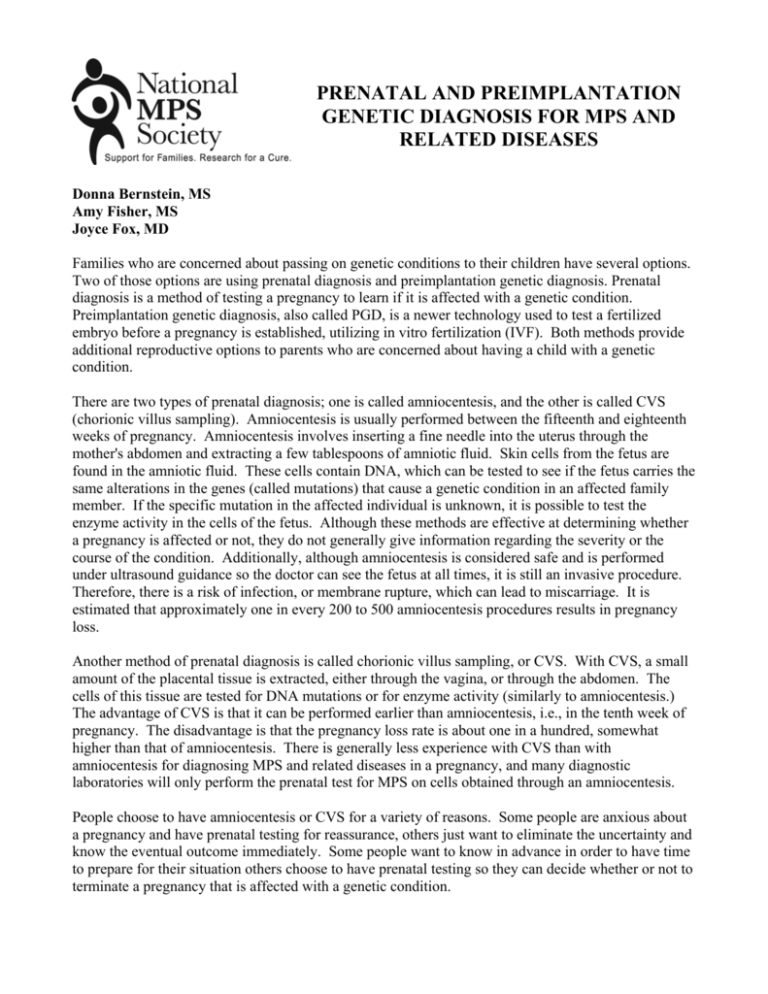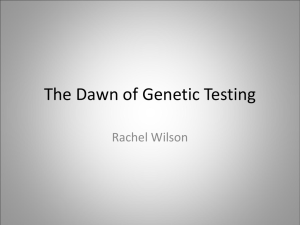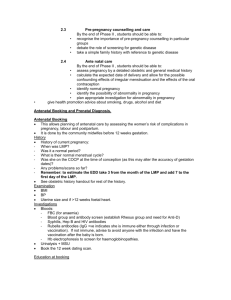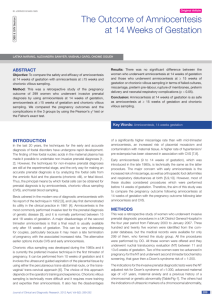Prenatal and Preimplantation Diagnosis
advertisement

PRENATAL AND PREIMPLANTATION GENETIC DIAGNOSIS FOR MPS AND RELATED DISEASES Donna Bernstein, MS Amy Fisher, MS Joyce Fox, MD Families who are concerned about passing on genetic conditions to their children have several options. Two of those options are using prenatal diagnosis and preimplantation genetic diagnosis. Prenatal diagnosis is a method of testing a pregnancy to learn if it is affected with a genetic condition. Preimplantation genetic diagnosis, also called PGD, is a newer technology used to test a fertilized embryo before a pregnancy is established, utilizing in vitro fertilization (IVF). Both methods provide additional reproductive options to parents who are concerned about having a child with a genetic condition. There are two types of prenatal diagnosis; one is called amniocentesis, and the other is called CVS (chorionic villus sampling). Amniocentesis is usually performed between the fifteenth and eighteenth weeks of pregnancy. Amniocentesis involves inserting a fine needle into the uterus through the mother's abdomen and extracting a few tablespoons of amniotic fluid. Skin cells from the fetus are found in the amniotic fluid. These cells contain DNA, which can be tested to see if the fetus carries the same alterations in the genes (called mutations) that cause a genetic condition in an affected family member. If the specific mutation in the affected individual is unknown, it is possible to test the enzyme activity in the cells of the fetus. Although these methods are effective at determining whether a pregnancy is affected or not, they do not generally give information regarding the severity or the course of the condition. Additionally, although amniocentesis is considered safe and is performed under ultrasound guidance so the doctor can see the fetus at all times, it is still an invasive procedure. Therefore, there is a risk of infection, or membrane rupture, which can lead to miscarriage. It is estimated that approximately one in every 200 to 500 amniocentesis procedures results in pregnancy loss. Another method of prenatal diagnosis is called chorionic villus sampling, or CVS. With CVS, a small amount of the placental tissue is extracted, either through the vagina, or through the abdomen. The cells of this tissue are tested for DNA mutations or for enzyme activity (similarly to amniocentesis.) The advantage of CVS is that it can be performed earlier than amniocentesis, i.e., in the tenth week of pregnancy. The disadvantage is that the pregnancy loss rate is about one in a hundred, somewhat higher than that of amniocentesis. There is generally less experience with CVS than with amniocentesis for diagnosing MPS and related diseases in a pregnancy, and many diagnostic laboratories will only perform the prenatal test for MPS on cells obtained through an amniocentesis. People choose to have amniocentesis or CVS for a variety of reasons. Some people are anxious about a pregnancy and have prenatal testing for reassurance, others just want to eliminate the uncertainty and know the eventual outcome immediately. Some people want to know in advance in order to have time to prepare for their situation others choose to have prenatal testing so they can decide whether or not to terminate a pregnancy that is affected with a genetic condition. Preimplantation genetic diagnosis (PGD) tests the embryo before a pregnancy is established. Unlike amniocentesis or CVS, one must know the DNA mutations to pursue PGD. In vitro fertilization (IVF), a method of placing sperm and eggs together in a petri dish, is used in PGD. Sometimes a method called ICSI (intracytoplasmic sperm injection) is used to establish fertilization instead of IVF. ICSI is similar to IVF except the sperm is injected directly into the egg. After fertilization takes place under either method, the fertilized egg undergoes cell division. At the eightcell stage, one or two cells are removed and tested for the genetic condition. At this early stage removing one or two cells does not affect the development of the embryo. After the embryos are tested, only the embryos that are unaffected are implanted into the mother's womb. Usually several eggs are fertilized when performing PGD in order to increase the likelihood of having an unaffected embryo that can be successfully implanted. One of the main advantages of PGD over prenatal diagnosis is that genetic testing is performed before the embryo is implanted in the womb. This eliminates the need to decide whether or not to terminate an affected pregnancy. Therefore, couples who are not comfortable with terminating a pregnancy may prefer using PGD to avoid having an affected child. However, PGD is expensive and is not always covered by insurance. Further, even at the best reproductive medical centers, the success rate is only approximately 30% per cycle. That means that it may take three attemps or more before achieving a successful pregnancy that goes to term. Also, the process of IVF or ICSI requires fertility drugs, monitoring, and surgical procedures to retrieve the eggs and to implant the embryos. However, PGD does offer parents the option of having an unaffected pregnancy without facing the issue of terminating a pregnancy. The decision to have prenatal diagnosis or preimplantation genetic diagnosis is both complex and personal. An appointment with a genetic counselor is recommended to explore these options and their implications on an individual, case-by-case basis. This fact sheet is not intended to replace medical advice or care. The contents of and opinions expressed in the fact sheet do not necessarily reflect the views of the National MPS Society or its membership.











